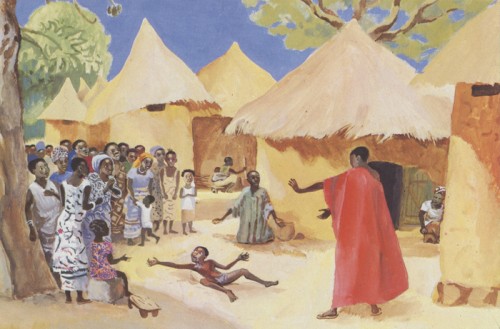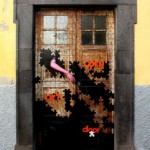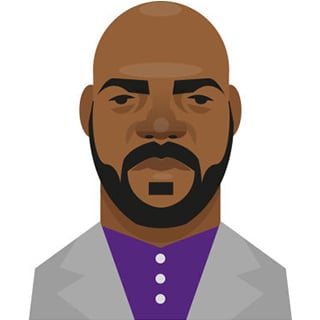![]() A slave, then a dead man, next a prostitute, and now a madman – Luke piles one story on top of another showing how Jesus widens the circle of the people of God to include those who have been seen as contaminated and corrupting – the unclean. Two thousand years later, the mentally ill are the group we still fear, and shun.
A slave, then a dead man, next a prostitute, and now a madman – Luke piles one story on top of another showing how Jesus widens the circle of the people of God to include those who have been seen as contaminated and corrupting – the unclean. Two thousand years later, the mentally ill are the group we still fear, and shun.
Luke has placed this mad young man in an unclean town, a town on the far side of the Sea of Galilee, in which Jewish people made their living by herding pigs. By Jewish law the pig is an unclean animal, but the town has found it profitable to raise them and sell to neighbors of other faiths who are pork eaters. At least this. Perhaps more.
The madman is also untouchable by religious law. The town, Gerasea, has decided that the young madman is good for nothing. His uncontrollable rages have brought them to drastic measures. They have put him in chains and chained him among the dead, in the town cemetery, where his roaring will bother the living less. Even so, he manages to escape now and then and takes off into the woods. Why does he return? Because there is nowhere else to go. Because hunger brings him back to the food they will supply. Because they go after him. Who knows?
When Jesus arrives by boat from across the Sea, there is no crowd waiting to greet him. His advance team has not been able to roust folks out – curiosity, hope for miracles, and longing for good preaching, the three sure-fire lures, have failed in Gerasea. But Jesus and the disciples can hear the fellow in the cemetery. And they go to him. By the end of Jesus’ time with him, the young man has been restored to sanity, is calm and rejoices in his acceptance by them all.
But something else has happened. The demons and the madness have gone out of the young man and, at Jesus’ direction, into a large herd of swine. The swine, in horror at their own corruption by unclean spirits, run to the edge of the cliff, jump into the Sea and are drowned. Now the townspeople come running, crowding around, horrified at the loss of their valuable swine. And they are terrified of Jesus – so terrified they ask him to leave town.
Jesus has changed the town, from a place in which everyone was corrupt and a young man’s soul had been lost, to a place where everyone was set free from corruption and madness. But the cost has been high, financially. And the town does not want to pay it, nor to live in freedom without that income.
And who can blame them, economies being what they are? New livelihoods are not easy to come by, and this village needs to salvage its hogtending, pronto. Besides, it is foolish to declare one animal unclean when we can see others eating it and not dying. In a way Jesus has shown the pig to be a clean creature, for it, unlike the humans, did not consent to live when polluted by the demons. Jesus has shown that pigs were corrupted by the spirits of people, instead of the other way around.
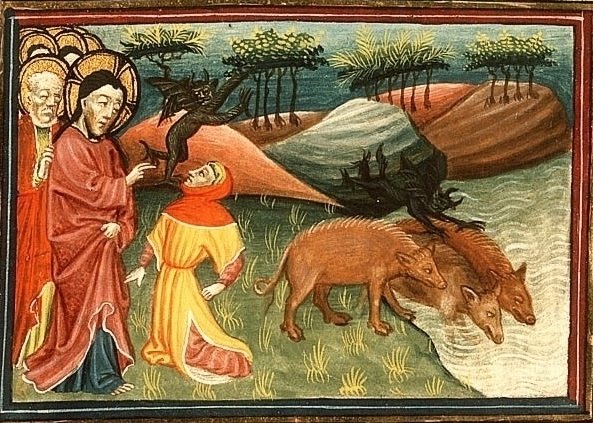 Mental illness is no stranger in America. And the confusion and corruption of American life may push many young people who are fragile, over the edge. The agony of families with members afflicted by devouring anxieties, and the anguish of being in such a state, are tragedies beyond words.
Mental illness is no stranger in America. And the confusion and corruption of American life may push many young people who are fragile, over the edge. The agony of families with members afflicted by devouring anxieties, and the anguish of being in such a state, are tragedies beyond words.
In America, social pressures seem to contribute to such illnesses. We have a significant economic market in manufacture and sale of guns. And it is fueled by another successful industry, films and fantasy cyber games that celebrate gun violence. The widespread availability of semi-automatic repeating rifles is one of our cultural corruptions. Another is the fantasy world that feeds it, and still another is the interpretation of the second amendment as enshrining anti-social rage and the right to a personal arsenal.
Many, speaking in the name of Jesus’ values, especially since the Sandy Hook shootings, have urged the curtailing of guns sales and the setting of limits on movies and games about violence. But the counter argument has so far won the day, that the right to own such guns and play such games is sacred. Instead, the mentally ill have become scapegoats for the perils we face, all across the nation.
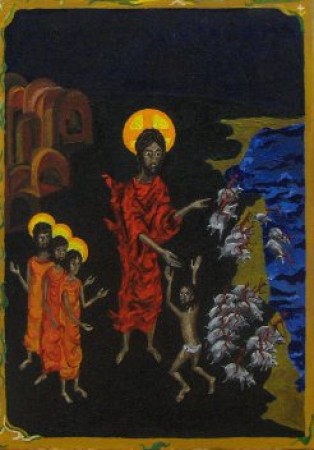 It was not the mad young man who endangered Geresea, it was the collaboration in corruption in which the town was engaged. And the sanest of men, Jesus, knew that and remedied it. The town turned that remedy down.
It was not the mad young man who endangered Geresea, it was the collaboration in corruption in which the town was engaged. And the sanest of men, Jesus, knew that and remedied it. The town turned that remedy down.
Statistically, the mentally ill are no more prone to violence than anyone else. Spiritually, it would be true to say that any shooter is, at the time of shooting, insane. But whatever we say, it seems that, then and now, money always wins the day.
Jesus told the now-sane young man, who wanted to stay with him as a disciple, to stay instead in Geresea and keep on telling people how his cure had come about. That story would be about Jesus, but also about the swine. And about money.
In America, the mentally ill need to keep on telling us all that, sick or well, they are not the root cause of violence here. And that doing something to curtail the violence in America could be very helpful in their healing.
Even more helpful would be ceasing to scapegoat the mentally ill, ceasing to see them as lurking monsters who need to be kept in chains. Mental illness is part of the spectrum of the human condition. It has always been present, and will always be. And like the rest of us, the mentally ill need to be safe in our communities. Jesus, who had such compassion for this young man, knew the community could afford to restore him to health. They just needed to care enough to be willing to pay for his wellness. And they needed to understand that his health was a symbol of theirs.
____________________________________________________
Illustrations
1. Healing at Geresea – personal icon of Rev. Brian McHugh.
2. Healing the Possessed, JESUS MAFA, 1973, Cameroon,
Vanderbilt Divinity School Library, Art in the Christian Tradition.
3. Jesus Heals the Gerasene, Alexander Master, 1430, The Hague, Kinoinikliijike Bibliotheek. Vanderbilt Divinity School Library, Art in the Christian Tradition.
4. Geresene Demoniac, unidentifiable icon.

